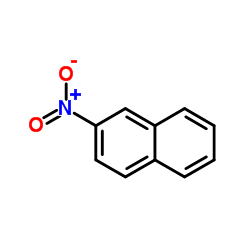2-Nitronaphthalene

2-Nitronaphthalene structure
|
Common Name | 2-Nitronaphthalene | ||
|---|---|---|---|---|
| CAS Number | 581-89-5 | Molecular Weight | 173.168 | |
| Density | 1.3±0.1 g/cm3 | Boiling Point | 319.6±11.0 °C at 760 mmHg | |
| Molecular Formula | C10H7NO2 | Melting Point | 65-73 °C | |
| MSDS | Chinese USA | Flash Point | 158.7±12.1 °C | |
| Symbol |



GHS02, GHS08, GHS09 |
Signal Word | Danger | |
|
Comparative cytotoxicity of naphthalene and its monomethyl- and mononitro-derivatives in the mouse lung.
J. Appl. Toxicol. 6(1) , 13-20, (1986) Male Swiss-Webster mice were exposed to naphthalene, 1-methyl-, 2-methyl-, 1-nitro- and 2-nitronaphthalene by intraperitoneal injection of peanut oil solutions over a dose range of 0.5-3.0 mmol kg-1 body weight. Treated mice were killed at times from 6 hours ... |
|
|
Induction of LacZ mutations in Muta Mouse can distinguish carcinogenic from non-carcinogenic analogues of diaminotoluenes and nitronaphthalenes.
Mutat. Res. 608(1) , 88-96, (2006) 2,4-Diaminotoluene (2,4-DAT) is a liver carcinogen in rats and mice whereas 2,6-DAT is not. Both are genotoxic in vitro. Tests for mutations in transgenic mice, unscheduled DNA synthesis (UDS), DNA damage and enhancement of initiated foci in vivo have shown s... |
|
|
1-nitronaphthalene.
IARC Monogr. Eval. Carcinog. Risks Hum. 46 , 303-12, (1989)
|
|
|
Comparison of in vivo binding of aromatic nitro and amino compounds to rat hemoglobin.
Biochem. Pharmacol. 38(20) , 3511-9, (1989) The hemoglobin (Hb) binding of five nitroarenes, i.e. nitrobenzene (NB), 4-nitrobiphenyl (4-NBP), 1-nitropyrene (1-NP), 2-nitronaphthalene (2-NN) and 2-nitrofluorene (2-NF), and the corresponding amines, administered p.o. to male S.D. rats, was determined by ... |
|
|
Comparison of the sensitivity of Salmonella typhimurium strains YG1024 and YG1012 for detecting the mutagenicity of aromatic amines and nitroarenes.
Mutat. Res. 301(1) , 7-12, (1993) Salmonella typhimurium YG1024 is a derivative of S. typhimurium TA98 with a high level of N-hydroxyarylamine O-acetyltransferase (OAT) activity. We have demonstrated that this strain is highly sensitive to the mutagenic actions of N-hydroxyarylamines derived ... |
|
|
Modulation of chemical-induced lung and liver toxicity by all-trans-retinol in the male Sprague-Dawley rat.
Toxicology 105(2-3) , 237-49, (1995) We have previously shown that retinol pretreatment limits the amount of pulmonary injury caused by 1-nitronaphthalene in male Sprague-Dawley rats. The main objective of this study was to determine if retinol pretreatment can protect the lung from the toxicity... |
|
|
Polarographic and voltammetric determination of trace amounts of 2-nitronaphthalene.
Anal. Bioanal. Chem 381(2) , 520-5, (2005) The polarographic behaviour of 2-nitronaphthalene was investigated by DC tast polarography (DCTP) and differential pulse polarography (DPP), both at a dropping mercury electrode, and differential pulse voltammetry and adsorptive stripping voltammetry, both at... |
|
|
Evidence for oxidative metabolism in the genotoxicity of the atmospheric reaction product 2-nitronaphthalene in human lymphoblastoid cell lines.
Mutat. Res. 445(1) , 113-25, (1999) 2-Nitronaphthalene (2NN) has been identified as a mutagenic atmospheric reaction product of naphthalene in the Ames bacterial reversion assay. Recent experiments have shown this nitroarene to be genotoxic in a human lymphoblastoid cell line (MCL-5) transfecte... |
|
|
all-trans-retinol modulation of nitronaphthalene-induced lung and liver injury in male Sprague-Dawley rats.
Proc. West. Pharmacol. Soc. 38 , 29-31, (1995)
|